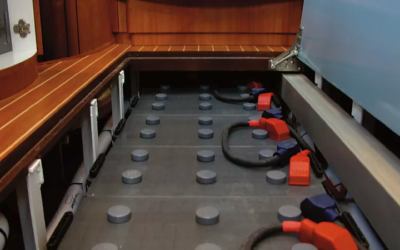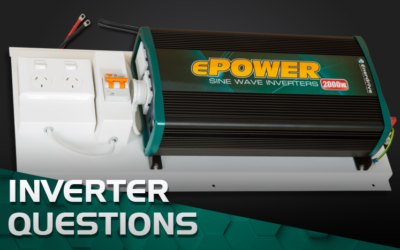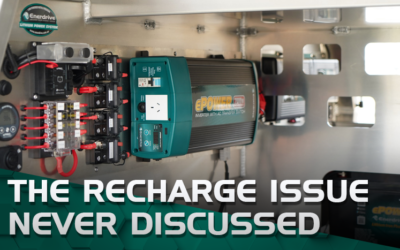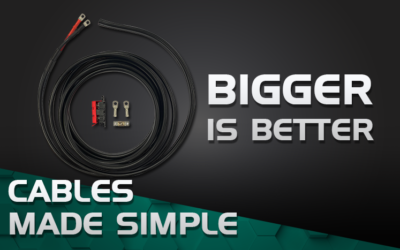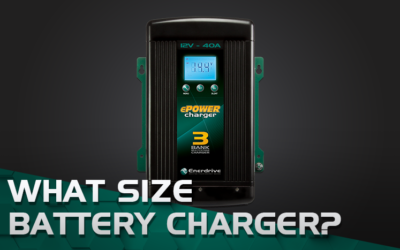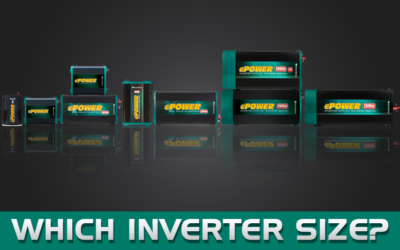There are several ways to wire multiple batteries to achieve the correct battery voltage or capacity for a particular DC installation. By connecting batteries in series or parallel or both as one big bank, rather than having individual banks will make your power...
FAQ’s
All categories
Everything you need to know about inverters
Wanting to learn more about inverters? Read below for the most frequently asked inverter questions. Alternatively, click on the links below to jump to a specific section: How long will my batteries last? Each time I run my inverter, a high pitched alarm is sounding...
Cable Sizes: Choosing the right one for a DC Circuit
How to Choose the Right Size DC Cable for Your 4×4, Caravan, RV or Boat.
Can I charge my lithium battery with a lead acid charger?
Can I charge my lithium battery with a lead acid charger? This is a question we get asked every day by the general public. Lithium batteries are not like lead acid and not all battery chargers are the same.
Everything You Need to Know About Enerdrive Inverters (Transfer Models)
OUR COMPREHENSIVE GUIDE TO ENERDRIVE INVERTERS (TRANSFER MODELS) We've built a comprehensive guide to Enerdrive Inverters, covering everything from the installation process, all the way to programming and fault finding. Perfect for those in the market for an inverter,...
Everything You Need to Know About Enerdrive DC2DC Chargers
OUR COMPREHENSIVE GUIDE TO ENERDRIVE DC2DC CHARGERS Enerdrive's DC2DC Chargers are often a staple in any power system, whether that be for a beginner who is just starting to explore the off-grid life, or a seasoned veteran with all the bells and whistles. As you can...
Should You Use a 48V Battery System?
12V & 24V SYSTEM VS 48V BATTERY SYSTEM: At Enerdrive we have seen a lot of talk & been asked about using 48v battery banks in caravans, motorhomes and sometimes even utes for the house battery setup due to the slightly better efficiency of components and...
Cables made simple
Cables are integral to your system, but often the weakest link of an electrical install. Read below for the information that will matter most to you: Table of Contents: Introduction Application Operating Voltage Operating Environment Circuit Type Current Carrying...
Cable Connections: The massive impact on battery charge/discharge
More often than not a loose connection or poorly connected cable in your DC system will heavily affect charging and discharging of your battery. We get many phone calls complaining that our charger is in float but the battery monitor is only showing 60% charge. 99.5%...
How do I choose the right fuse?
This is the second in a two part series of technical briefs on circuit protection. Part 1 showed how to choose the correct wire size for DC circuits. Part 2 will show how to correctly select a fuse and fuse holder for your DC electrical installation. Regulations...
What Size Battery Charger Do I Need?
Battery charger size is based on the overall battery capacity that you have as well as allowing for what loads you would normally run when the battery charger is operating. The key to any battery charger is the basic operation. When a charging source is operating, it...
How Much Solar Do I Really Need?
This is a question we get asked every day. With most caravaners these days spending more time off the grid compared to being plugged in at a caravan park, solar becomes their primary charging source. Caravan manufactures today are generally installing a single 150w...
What’s the largest battery charger I can run on my 1kVA generator?
What’s the largest battery charger I can run on my 1kVA generator? This is another question we get asked regularly. Taking the most popular 1kVA generator on the market today (Honda EU10i), this unit can produce a maximum output (for a short period) of 1000Watts....
The DC Charger in my caravan isn’t charging properly
I have a DC charger in my caravan, but it doesn’t seem to charge properly? With pretty much all new vehicles these days running smart alternators, the requirement for DC chargers has increased exponentially. The biggest problem we see with DC chargers not operating...
Lithium Batteries: What Size Inverter Can I Use?
This is a question we get asked all the time. The size of the inverter is really dictated by the loads that you want to run. Let’s say your largest load is a microwave. A typical microwave will draw between 900-1200w. With this load you would install a minimum of...
Are Your Batteries Constantly Going Flat?
Are Your Batteries Constantly Going Flat? A large portion of DC power systems these days don’t come with any protection to stop the battery from being completely drained away when loads are running. Over discharging a battery can and will shorten its overall lifespan...
Does battery voltage alone tell me how full my batteries really are?
In short yes. It’s not an exact science but battery voltage will give you a very rough indication of battery capacity. Lithium on the other hand is extremely difficult to determine capacity due to the very flat voltage curve that lithium batteries have. Let’s look at...
How does an inverter work?
So you want to know how an inverter works? You've come to the right place! We'll also talk you through what you need to know to conduct a proper installation for optimal performance. Firstly, an inverter is a piece of equipment that works by converts DC battery power...
Flat v Angle Installation of Solar Panels
The positioning of solar panels determines the power output. The angle of the sun in relationship to the angle of the solar panel determines the maximum power density. The tilt angle has the biggest effect on the efficiency of the solar panel. When the angle of the...
Lithium Battery Overview
Lithium Battery Overview Lithium Based batteries are quickly becoming a reasonable replacement for the 150 year old technology of Lead-Acid batteries. In applications where weight is a consideration, Lithium batteries are among the lightest options available. In...
How to charge a flat battery with an ePOWER charger
Enerdrive Unplugged – A Wealth of Knowledge at Your Fingertips: Before you jump into our explanation of charging a flat battery with an ePOWER charger, consider joining our community Facebook group – Enerdrive Unplugged. Designed to be an educational tool, you’ll find...
Why Do I Need Power Filtration Protection?
ALL electronic equipment that plugs into AC power should be protected. Without suitable protection, your expensive home theatre, sound system, TV, entertainment centre or computer equipment will likely be damaged by the surges and spikes that afflict our electrical...
What’s With Solar Panel Warranties?
There is so much confusion with solar panel warranties these days, and in our opinion so many of them are not worth the paper they are written on. There are two forms of warranty commonly used these days – Structural & Power. Let's focus on structural. This looks...
Explaining the Enerdrive eLITE Battery Monitor
[tm_pb_section admin_label="section"][tm_pb_row admin_label="row"][tm_pb_column type="4_4"][tm_pb_text admin_label="Text" text_orientation="left" use_border_color="off" border_color="#ffffff" border_style="solid"] Enerdrive's Battery Monitor Explained. We have created...
DC to DC Converters Explained
Step Up-Step Down, Isolated & Non Isolated, what does it all mean? What is a step up DC to DC Converter? A step-up dc-dc converter is an electronic circuit that raises the DC voltage level from a lower value to a higher value. Assuming an ideal converter (100%...
Exceeding The Morningstar MPPT Controller Maximum Input Power Rating.
This tech tip relates to the impact that Morningstar's TrakStar™ MPPT Technology has on PV Module Sizing and Power Ratings. You can improve performance and reduce costs for systems that would otherwise suffer from reduced power input and inconsistent levels of...
Morningstar String Sizing Calculator
The Morningstar string sizing calculator is used to determine the number of PV modules you may use with any Morningstar controller while staying within the controller specs. Recently Morningstar has updated their string calculator interface. Some of the new features...
Appliance & Load Questions:
Appliance & load questions that are frequently asked at Enerdrive. Do I need a pure sine wave inverter to run a television? In short, No. By using a modified sine wave inverter you will find that lines will appear across the screen. The best method to run any...
Battery Systems
Good advise for battery systems. Do not discharge starting batteries below around 90% state of charge. Starting batteries are not designed to sustain DC loads for any length of time (Look how quickly car batteries go flat if a light is left on). Do not discharge deep...
Inverter Summary
Inverter Summary One thing that you will find in the market place are substantial price differences from one inverter to another, not only between Modified and Pure sine wave but also between different brands. Due to the market for such items becoming more...
Maximising Charge Sources
Maximising Your Charge Sources One of the most common comments we receive from users across the market is the statement "we run from a solar system", but do not elaborate any further on what makes up their total "System". Using the term "Solar System" is really a...
Economical System Sizing
Our recommendations when it comes to system sizing is this: Sit down and list everything that you would ever want to run from your power inverter. Once this is done, look for any appliance with a power rating above 2000watts and strike these off your list (or be sure...
Inverter Output Waveforms
Inverter Output Waveforms Pure Sine Wave and Modified Sine Wave. The differences between these types of inverter output waveforms are subtle, but significant in the way that they operate certain types of loads. Modified Sine wave Inverters These units are...
Realistic Inverter Loads Explained
What can I run from my Inverter ... Realistically. When using inverters many people have different conceptions of what are realistic inverter loads. Here is a general overview of What's Real & What's Dreaming. Basic household AC appliances such as Televisions,...
Voltage Problems? See Our Cable Size Chart.
In an independent power system, you generally would find an inverter and battery charger system working to the common goal of providing power. What ties each of these together are the battery cables to supply the power to run to or from the batteries and...
MPPT vs PWM Solar Controllers
MPPT vs PWM: Which one is the best solar controller for my system? We have compiled a small amount of information that will hopefully help you to understand better what the difference is, and what type you should opt for in the MPPT vs PWM debate when it comes to your...
What is an inverter?
Modern inverters have caused a quiet revolution in the way we live with independent power systems, by providing silent 240 volt AC electricity anytime, anywhere. So, just what is an inverter? An inverter transforms the DC electricity stored in your batteries into...
